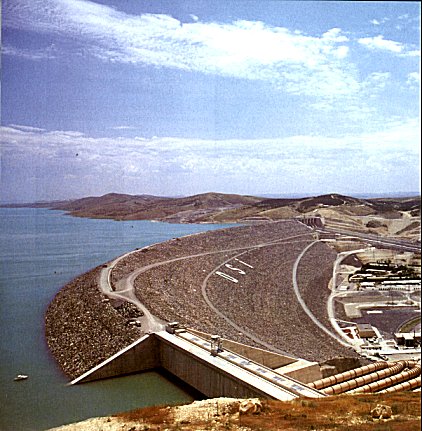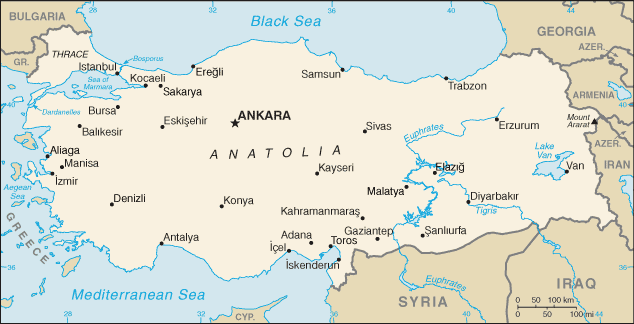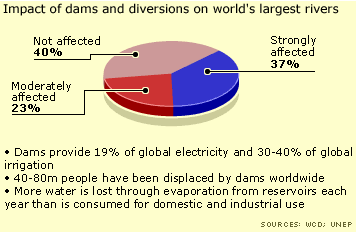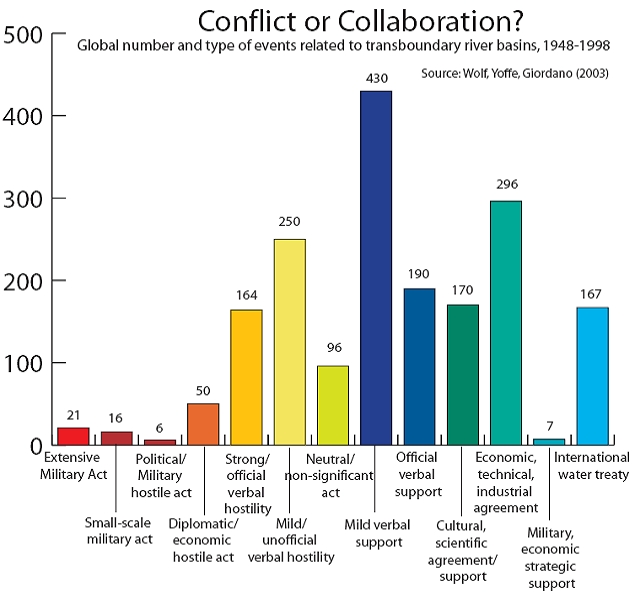
| ICE Case Studies
|
Turkey, Dams, Kurds, and Conflict Within and Between Countries by Navid Ahdieh |
I.
Case Background |

Ataturk Dam
http://www.turkiye-online.com/travel/southeasternanatolia/images/8.jpg

Hydropolitics—the study of conflict and cooperation among nations over shared water resources (Elhance 1999) —has increased in importance as a field as scholars have recently focused on the potential for conflict over the world’s 200-plus trans-boundary river basins.Those basins that cover already-contentious regions, or those located in regions with an existent relative scarcity of water, are the most demanding of attention. The Euphrates-Tigris River Basin, by possessing both of these elements of concern, brings this issue into the forefront of hydropolitical considerations. The Southeastern Anatolia Project (GAP) is an ambitious development project meant to control, sustain, and distribute the water resources of this river basin from within Turkey, the nation which serves as the source of 88% of the Euphrates’s water and 43% of the Tigris River (Lupu 2002). The project poses major multi-scalar implications, both positive and negative. Its impacts range from soil degradation to local Kurdish resettlement to insufficient water provisions for Iraq and Syria to regional economic development.
"In this new century, water, its sanitation, and its equitable distribution pose great social challenges for our world. We need to safeguard the global supply of healthy water and to ensure that everyone has access to it." ~ Kofi Annan, World Water Day, March 22, 2001
TURKEY

https://www.cia.gov/cia/publications/factbook/geos/tu.html
GAP PROJECT REGION

http://www.pedology.net/sitebuildercontent/sitebuilderpictures/tr-gap1.jpg
The Tigris and Euphrates Rivers both originate in the Anatolian Highlands of Turkey and flow through Syria and Iraq. Turkey contributes 88 percent of the water flow of the Euphrates River and 43 percent for the Tigris, making Syria and Iraq heavily dependent on external supplies of water (Lupu 2002). In addition to Turkey’s geographic advantage, its recent water management policies and large-scale irrigation and hydro-energy projects, particularly the Guneydogu Anadolu Projesi (GAP, Southeast Anatolia Project), put Turkey in a position of great command over the river basin. GAP has the potential for optimal use of land and water resources in Southeast Anatolia to provide for Turkey as a whole, and for sustainable socio-economic development in the poor, largely Kurdish populated region, characterized by social and economic instability. Conversely, both Syria and Iraq contend that GAP could diminish and degrade their water supply in the years to come. Water shortage is especially a threat in the region due to the history of drought in Syria and the political instability and war-torn infrastructure of Iraq. Equitable and effective methods of sharing the waters will allow the riparian states to prevent water and food scarcity, while also conserving water. The key to attaining these goals is cooperation, both internal and external.
Internally, there is hope that GAP will eventually help resolve the Kurdish conflict in Turkey. The majority of the Kurdish population in Turkey resides in Southeast Anatolia. Armed conflict with Kurdish rebels is often incited by factors relating to the poor socio-economic development of the region. In addition, the social structure of the region is still largely feudalistic. There is a major inequality in land distribution. About 61% of the farmers (approximately 150,000 families) own less than five hectares and 10% of the population own 75% of the land. Economic development and an increase in resource investment in Southeast Anatolia may help to integrate the alienated Kurdish population and stop separatist PKK (Kurdistan Workers’ Party) activity by eliminating the economic motivation of the rebel movement (Carkoglu and Eder 2001).
The GAP region in southern and southeastern Turkey encompasses nine of the nation’s least developed provinces: Adiyaman, Batman, Diyarbakir, Gaziantep, Mardin, Siirt, Sanliurfa, Sirnak, and Kilis. This area covers 75,358 square kilometers, about 9.7 percent of the country’s total area. The region’s population reaches approximately 6.2 million people (Carkoglu 2001:44).
The GAP project, expected to be completed by 2017, will consist of a network of 22 dams, 19 hydroelectric plants, 1.7 million hectares of irrigated lands, and several related socio-economic redevelopment projects meant to support populations resettled by this ambitious effort. By that time, the GAP project will provide 23% of Turkey’s total energy supply (Unver 2002).
Aside from increased energy supply, other positives garnered from the GAP project include agricultural and socio-economic benefits. The expanded amounts of land under irrigation has allowed for more intensive crop cultivation and the introduction of non-native crops and export-oriented cash crops. These cash crops, such as cotton, are meant to replace traditional crops, such as rice, barley, oats, and wheats, grown for subsistence and local markets, in order to generate revenue for the region. Already, a 300% increase in small farm income has occurred as a result of GAP’s initiatives (GSI 2005:2).
Socio-economic benefits include the increased amounts of schools and hospitals now available in the region due to funding and support from multilateral banks and institutions. This has actually led to an improvement in women’s status in the region due to improved access to education and health care. These improvements in agricultural production and standards of living also have implications for cultural changes in the local populations.
These changes, although positive in some aspects, also have long-term negative impacts. Due to the historical animosity between Turks and Kurds in the region, any cultural changes in the local populations, in terms of social status and agricultural traditions, may also pose a threat to the norms of local societies resulting in potential backlashes if the changes and benefits are perceived to be one-sided (the perks being channeled to Ankara) or too radical. Other cultural problems include the rapid loss of access to important archaeological sites, often located in valleys flooded by the project’s dams.
Besides cultural impacts, other negative impacts may also result. The expansion of cotton cultivation bodes well for economic income in the region, but raises concerns regarding the health of soils in the region over time since cottons have been proven to degrade soils. Also, the massive expansion of water availability in the form of vast reservoirs of dammed river water also elevates the risk for higher levels of evaporation in the region, resulting in potentially diminished water access in the future. In terms of health impacts, the now increased amounts of standing water nurture habitats conducive to mosquito procreation, and subsequently heighten the risk of exposure to malaria (Harris 2002).
Further complicating matters, a diversity of ethnic groups with a history of conflict with the Turkish government, inhabit the region being altered by the GAP project. The area being developed by the Turkish government is heavily populated by the Kurds and to a lesser extent, by ethnic Armenians as well. The Turkish government has a history of denying the rights and even the political and cultural existence of both Kurds and Armenians. From the exterminations of over a million Armenians after the turn of the twentieth century, a series of events still denied by Turkish society, to the incarcerations, exiles, and assassinations of Kurdish political and separatist leaders, the Turkish government and the ethnic groups resident in the Euphrates-Tigris headwaters region have undeniable enmity between one another.
Coupled with the ongoing social instability in the region is the argument that dam infrastructure projects often heighten and intensify divisions between societal units. As mentioned by Denis Goulet, “Large dams, long viewed as beneficial and essential to development, have become sites of major social conflict” (Goulet 2005:881). Causes of such conflict include the forced relocation of large amounts of people from lands of historical, traditional, and agricultural importance, and insufficient returns of the economic benefits to the local region impacted by the project.
In addition to social impacts, dam construction produces many irreversible environmental effects as well. “Dams change the character of rivers” and riparian ecosystems (Cech 2005:197). Changes caused by dam infrastructure include: irregular temperature variations in river water; prevention of fish migration and subsequent disruption in aquatic biodiversity balance; irregular water releases from reservoirs and subsequent large-volume sediment flows; and sediment buildup within reservoirs and subsequent reduction in storage capacity.

http://news.bbc.co.uk/2/hi/in_depth/world/2003/world_forum/water/default.stm#
Altogether, the GAP project’s many social, political, and environmental impacts make for an extremely convoluted issue. However, even more dire impacts may occur on the larger, international scale. Experts believe that the basin may already be running a deficit when comparing consumption/recharge rates (Beaumont 1998:178-179). Considering that t he World Bank estimates that the total populations of the riparian countries will grow from 96 million in 1995 to 138 million in 2010, present scarcity may only become more drastic (Lupu 2002). Scarcity will only become more of a concern as scientists predict global climate change and regional climatic warming will occur in the region.
As the upstream riparian in the Euphrates-Tigris River Basin, Turkey enjoys respectable power and control over the fates of the downstream riparians (i.e. Iraq and Syria). Turkey also has access to more water sources and receives more rainfall than its riparian neighbors; Syria and Iraq, on the other hand, are extremely dependent upon the Euphrates and Tigris rivers for their water needs (Freeman 2001:130-131). The GAP project, by constructing river damming infrastructure and controlling water flows, further enhances Turkey’s potential domination over other nations’ access to sufficient amounts of water, threatening an already shaky balance in the region.
Begin Year: 1925
End Year: Ongoing
Duration: 82 years
Violent conflict between Kurds and Turkish authorities began in 1925.
Continent: Asia
Region: Middle East
Country: Turkey, especially the southeastern Anatolian region
Sovereign Actors: Turkish government and military, Syrian government, Iraqi government.
Non-sovereign Actors: Kurdish rebel groups, paramilitary and independence parties, especially the PKK.

General Habitat Loss
Source Problem:
Habitat Loss (HABIT)
The GAP project is causing a loss of natural buffer zones along the natural course of the river. This has negative impacts on riparian wildlife. Dams create physical barriers to fish migration, preventing them from reproducing, unsettling the natural balance of the ecosystem, and thus creating biodiversity loss. It also floods fertile valleys and creates more man-made boundaries to land open for terrestrial wildlife.
Deforestation may also become a problem since people are being removed from valleys which are being flooded by the damming of the local rivers. The displaced population is likely being resettled in areas that will have to make room for them. This means that without protection, this already dry region maybe losing forested land to make room for, and help provide for resettlement.
Southeastern Anatolia, where the GAP project is being implemented is primarily a dryland habitat, although the region is quite fertile and includes some temperate forests.
There are several combinations of Act and Harm caused by the GAP project, which is why it is such a vital and potentially dangerous issue.
Nation A impacts Nation A: Turkey dams the Tigris and Euphrates Rivers to develop its poorest region, which also happens to be where a majority of Kurds reside.
This is the focus of this project: how the GAP project is impacting the Kurdish people who inhabit the areas being flooded by the dam infrastructure under construction and the associated socio-economic projects aimed to mitigate negative impacts from resettlement.
Other important impacts also exist:
Nation A impacts Nation B: Turkey’s GAP project could potentially create major water availability issues for Syria and Iraq.
With this project, Turkey can now control how much water flows through the Tigris & Euphrates rivers, the lifelines of Eastern Syria and all of Iraq. Currently, Turkey contributes 88 percent of the water flow of the Euphrates River and 43 percent for the Tigris.
Composition of the Euphrates and Tigris Rivers
| RIVERS | RIPARIANS |
Composition of Length (%) (Kliot 1994) |
Contribution of Flow (%) (Lupu 2002) |
Consumption (%) (Adams 2002) |
|---|---|---|---|---|
| Euphrates Total Length - 3000 km |
Turkey |
41 |
88 |
35 |
Syria |
23 |
12 |
21 |
|
Iraq |
36 |
0 |
44 |
|
| Tigris Total Length - 1850 km |
Turkey |
22 |
43 |
- |
Syria |
1 |
0 |
- |
|
Iraq |
77 |
42 |
- |
|
Iran |
- |
9 |
- |
Sources: Kliot 100 (1994); Lupu 352 (2002); Adams 24 (2002).

CIVIL
a. Intrastate: Low (currently <100 fatalities per year).
b. Interstate: Threat
The civil conflict between Kurds and the Turkish government is currently low level, but still a threat to the stability of much of Turkey and its neighbors. This conflict extends into parts of Syria, Iraq, Iran, Armenia and even further.
This dispute can be measured at above a Level 6 conflict (i.e. >100,000 fatalities) over the course of the 20th century. Since 2000, however, it may be measured as a Level 3 conflict (i.e. >100 fatalities).
The total number of deaths through three major Kurdish uprisings in Turkey in the 20th century (1925-28, 1937-38, 1984-present) could number as high as 330,000. The number of deaths since the latest war's outbreak in 1984 had risen beyond 12,000 by 1994. According to official figures, more than 1,500 PKK guerrillas were killed and 7,600 captured during the first eleven months of 1993. During the same period, the number of government security personnel killed came to 676. Civilian deaths totaled 1,249, more than double the 1992 total (http://www.globalsecurity.org/military/world/war/kurdistan-turkey.htm ). The latest war has claimed between 30,000 and 40,000 lives since 1984 (http://www.ploughshares.ca/libraries/ACRText/ACR-Turkey.html).
Turkey (1925-28) Kurdish uprising
David McDowall, A Modern History of the Kurds (1996) says that Kurdish "propaganda
reports" claiming that 15,000 were massacred and that 200,000 deportees
perished "may have been exaggerated".
Dan Smith believes them: "Turkish troops crush Kurdish uprising killing
250,000." http://users.erols.com/mwhite28/warstat3.htm
Turkey (1937-38) Dersim Revolt, Govt. vs. Kurds
David McDowall, A Modern History of the Kurds (1996): 40,000
In Turkey (1980’s & 1990’s):
4 April 95 Washington Post: 15,000 (1985-95)
B&J: 18,000 (1984-95)
Ploughshares 2000: 30-40,000
29 April 1999 AP: 37,000 (1984-99)
23 May 1999 Denver Rocky Mtn News: 40,000 (1984-99)
Adding the maximum estimates from each revolt, the maximum estimate of fatalities
from this conflict could be as high as 330,000. Many civilians killed in the
conflict died of direct violence from both the Kurdish and Turkish sides. Some
also died due to starvation and disease, while a significant amount died during
forced migrations, village burnings and destructions, and from neglect and torture
in prison. At least 132 people (military and civilian) have been killed since 2000.

http://water.csis.org/global_water_futures_brochure.pdf

Direct (Water)
Causal Diagram
The conflict in the GAP project region of southeastern Turkey is more a Direct case since historical Kurdish conflicts in the region have occurred over lack of access to resources and a perceived economic preference for Turks. The purpose of the GAP project is to offer more water availability for the region’s population by damming the Tigris and Euphrates rivers, creating massive reservoirs meant to feed increased irrigation. This, in turn, helps to increase crop yields and a diversity of crops grown, increasing agricultural revenues and regional incomes. An Indirect case comes in to play as climate change could potentially cause an increase of evaporation of the now free-standing pools of water in the reservoirs, thus causing less water availability in the long run. If the region gets drier through climate change (as predicted by the IPCC), access to the water harnessed by the GAP project may become more limited, thus heightening the potential for conflict once again.
REGIONAL
The GAP project causes major impacts across multiple scales, however, the regional scale is the most pertinent to this case study:
Multilateral – Trapping water in the highlands of Turkey gives Turkey the advantage of being able to control and determine how much water can then flow through the Tigris and Euphrates to reach Syria and Iraq. As of yet, there are not multilateral treaties to ensure sufficient amounts of river flow to satisfy all three nations. Only bilateral treaties have been signed, of which Turkey always holds the ability to ignore due to its strategic and military advantage over its neighbors.
Regional – Regional concerns come into play since Kurds, who are directly impacted by the GAP project in Turkey, are located in large populations throughout the region, including significant populations in Iran, Iraq, and Syria. Although there is a history of disunity between the Kurdish minorities of each of these nations, Kurdish concern for negative impacts on their Turkish brethren must be considered.
State – At the state level, Turkey is quite concerned about a continued violent struggle with its significant Kurdish minority population. This concern is not limited to the area of southern Turkey which is the traditional homeland of the Kurds, but also to the large population of urbanized Kurds in cities like Istanbul and Ankara.
Sub-state – The GAP project’s impact on Kurds in their traditional homelands in south-central Turkey is significant. The dam construction is causing mass displacement of Kurds. The construction of the Ataturk Dam alone caused the resettlement of over 11,000 Kurds between 1988 and 1997 (Tortajada 461-462).
IN PROGRESS
From the perspective of the “decision-maker,” i.e. the Turkish government, the dispute result would be considered a victory since they captured and have imprisoned the former PKK rebel leader Abdullah Ocalan and incidence of outright violence and threats to the Turkish military have declined in the past 10 years. However, in reality the conflict should be considered an ongoing stalemate since violent Kurdish rebel activity has not been completely eradicated and deadly attacks on the Turkish military, civilians, and even random tourists still occur as a means to maintain global attention on Kurdish demands for increased autonomy and cultural acceptance.

First: Keyword/Free Text Search – “Kurd”:
No. 152 Kirkuk: Kurdistan: Ethnic Conflict and Oil in Iraq
No. 106 Iraqsanc: Iraq Sanctions
Second: Two Categorical Areas –
Country: “Turkey” –
No. 77 Tigris: Tigris-Euphrates River Dispute
No. 132 Ataturk: Ataturk Dam and Environment
No. 150 Noah: Noah, the Flood, and Water as a Weapon
Habitat: “Dry” –
No.152 - Kirkuk
No.24 Sahara: SAHARA DISPUTE AND ENVIRONMENT
No.103 Abumusa: Island Dispute Between Iran and the UAE
No.75 Somwar: Somalia: The Fallen Country
No.178 Khuzestan: Khuzestan: Oil, Ethnicity, and Conflict in Iran
No.132 – Ataturk
No.106 – Iraqsanc
No.30 Angola: Angola Diamond Mining and War
No.174 Aztec: CortÚs and Aztec Gold: Initial Conflict and Modern Political Ecology
No.31 Poach: Revisiting the Ban on African Elephant Ivory
Third: ICE Expert Sorts
Continent: Mideast
Region: Middle East in Asia
Country: Turkey
Habitat: Dry
Env. Problem: General Habitat Loss
Scope: Substate
Trigger: Infrastructure
Type: Civil
Outcome: Stalemate
Level of Conflict: Low
Beginning Year: Modern
Duration: 10 to 100 years
No.60 – Marsh: 75%
No.77 - Tigris: 67%
No.103 – Abumusa: 58%
No.76 Westbank: JORDAN RIVER DISPUTE: 58%
No.3 Sudan: Civil War in the Sudan: Resources or Religion?: 58%
No.31 - Poach: 50%
No.24 - Sahara: 50%
No.30 - Angola: 50%
No.69 - Aralsea: Aral Sea and Defense Issues: 50%
No.41 - Grainwar: Intellectual Property Rights & Biotechnology: Indian Seed Conflicts: 50%
Discussion:
In total, my case matched with 16 different case studies on the database. 10 of these cases (63%) were based on issues in the Middle East. 10 of the matching cases (63%) had something directly or indirectly to do with water issues. 8 of the matching cases (50%) had something directly or indirectly to do with conflict over oil. 4 of these cases overlapped by showing conflict over multiple resources (i.e. water and oil).
Kirkuk, Iraqsanc, Tigris, Ataturk, Sahara, Angola, and Poach occurred most frequently in my different searches (each one twice). Of these, the Tigris and Ataturk case studies deal most directly with my own topic on the GAP project and issues associated with the Tigris/Euphrates River Basin. Kirkuk and Iraqsanc deal mostly with Kurds, although with a focus on Iraqi Kurds. No case studies deal directly with Turkish Kurds. This is where the focus of my study will be. Tigris, Ataturk, Kirkuk, and Iraqsanc will likely be the four most helpful case studies for my own research.
Adams, Mark. “Water and Security Policy: The Case of Turkey.” Near East South Asia Center for Strategic Studies. National Defense University, 2002. <http://permanent.access.gpo.gov/websites/nduedu/www.ndu.edu/nesa/docs/marksadams-water.pdf>.
Beaumont, Peter. “Restructuring of Water Usage in the Tigris-Euphrates Basin: The Impact of Modern Water Management Policies.” Middle Eastern Natural Environments. Yale University School of Forestry and Environmental Studies Bulletin 103: 168-186, 1998. <http://www.yale.edu/environment/publications/bulletin/103pdfs/103beaumont.pdf>.
Carkoglu, Ali and Eder, Mine. “Domestic Concerns and the Water Conflict over the Euphrates-Tigris River Basin.” Middle Eastern Studies Vol.37 Iss.1: 41+, Jan 2001.
Cech, Thomas V. 2005. Principles of Water Resources: History, Development, Management, and Policy. Hoboken, NJ: John Wiley & Sons, Inc.
Elhance, Arun. Hydropolitics in the Third World: Conflict and Cooperation in International River Basins. Washington: U.S. Institute of Peace Press, 1999.
Freeman, Kevin. 2001. “Water Wars? Inequalities in the Tigris-Euphrates River Basin.” Geopolitics. Vol.6, No.2: 127-140 Autumn.
“GAP Master Plan.” GAP Administration, Ankara. Updated August 14, 2002 <www.gap.gov.tr/English/Ggbilgi/gtarihce.html>.
Global Strategy Institute (GSI). 2005. The Tigris and Euphrates River Basins: A New Look at Development. Center for Strategic and International Studies (CSIS).
Goulet, Denis. 2005. “Global Governance, Dam Conflicts, and Participation.” Human Rights Quarterly, 27.3. The Johns Hopkins University Press.
Gruen, G. E. “Turkish Waters: Source of Regional Conflict or Catalyst for Peace?” Water, Air and Soil Pollution 123: 565-579, 2000. <http://www.oranim.ac.il/courses/meast/water/fulltext3.pdf>.
Harris, Leila M. “Water and Conflict Geographies of the Southeastern Anatolia Project.” Society and Natural Resources 15: 743-759, 2002.
Kibaroglu, Aysegul. Building a Regime for the Waters of the Euphrates-Tigris River Basin. London: Kluwer Law International, 2002.
Kliot, Nurit. Water Resources and Conflict in the Middle East. London: Routledge, 1994.
Kolars, John. “Defining the Political/Ecological Threshold for the Euphrates and Tigris Rivers.” Arab Studies Quarterly Vol.22 Issues 2: 101+, Spring 2000. Academic Search Premier.
Lupu, Yonatan. “International Law and the Water of the Euphrates and Tigris.” Georgetown International Environmental Law Review. Vol.14, Iss.2: 349-366, 2002.
Shapland, Greg. Rivers of Discord. New York: St. Martin’s Press, 1997.
Swain, Ashok. Managing Water Conflict: Asia, Africa and the Middle East. London: Routledge, 2004.
Tomanbey, Mehmet. “Turkey’s Approach to Utilization of the Euphrates and Tigris Rivers.” Arab Studies Quarterly Vol.22 Issue 2: 79+, Spring 2000.
Tortajada, Cecilia. “Evaluation of Actual Impacts of the Ataturk Dam.” Water Resources Development Vol.16, No.4: 453-464, 2000.
Unver, Olcay. 2002. “ Southeastern Anatolia Development Project.” IIEEE Power Engineering Review, March 2002:1-3.
Zereini, Fathi and Jaeschke, Wofgang, ed. Water in the Middle East and North
Africa: Resources, Protection and Management. Berlin: Springer, 2002.

May 4, 2007